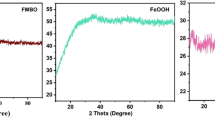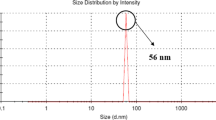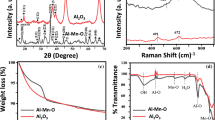Abstract
Trimetal oxides have received high attention in treatment of fluoride-polluted drinking waters. In this study, Mn-Al-La (MAL) oxide with a mole ratio of 2:1:1 was successively prepared and characterized by XRD, FTIR, XPS, and TEM. It exhibited as cotton-like assemblages (500–800 nm of axial lengths), and BET specific surface area was 52 m2/g. It was used to study fluoride adsorptions in aqueous solutions by batch experiments, under different adsorbent/adsorbate levels, times, temperatures, pH and coexisting anions, and treat simulated groundwater (with 2.85 mg/L fluoride and pH 7.0) by batch and column tests. Adsorption data well fitted to pseudo-second-order rate model (R2 = 0.996–0.999), and Langmuir (R2 = 0.962 − 0.997) and Freundlich (R2 = 0.964–0.989) isothermal models. Their maximum adsorption capacities could reach 45–113 mg/g. Only H2PO4− anions had a restrictive impact at pH 7.0, and there was a good removal ability at pH 3–9. Adsorption processes were spontaneous, endothermic, and random. Adsorption mechanisms were electrostatic interaction and ligand exchange at pH 7.0. Adsorption capacity could reach 73% of initial value at pH 7.0, after three cycles. All application data on the polluted groundwater treatments show MAL oxide is a potential adsorbent for fluoride removals.










Similar content being viewed by others
Data availability
Not applicable.
References
Alemu S, Mulugeta E, Zewge F, Chandravanshi BS (2014) Water defluoridation by aluminium oxide-manganese oxide composite material. Environ Technol 35:1893–1903. https://doi.org/10.1080/09593330.2014.885584
Cai JG, Zhang YY, Qian Y, Shan C, Pan BC (2018a) Enhanced defluoridation using novel millisphere nanocomposite of La-Doped Li-Al layered double hydroxides supported by polymeric anion exchanger. Sci Rep 8:1–10. https://doi.org/10.1038/s41598-018-29497-1
Cai JG, Zhao X, Zhang YY, Zhang QX, Pan BC (2018b) Enhanced fluoride removal by La-doped Li/Al layered double hydroxides. J Colloid Interface 509:353–359. https://doi.org/10.1016/j.jcis.2017.09.038
Chaudhary M, Maiti A (2020) Fe-Al-Mn@chitosan based metal oxides blended cellulose acetate mixed matrix membrane for fluoride decontamination from water: removal mechanisms and antibacterial behavior. J Membrane Sci 611:1–11. https://doi.org/10.1016/j.memsci.2020.118372
Chaudhary M, Rawat S, Jain N, Bhatnagar A, Maiti A (2019) Chitosan-Fe-Al-Mn metal oxyhydroxides composite as highly efficient fluoride scavenger for aqueous medium. Carbohydr Polym 216:140–148. https://doi.org/10.1016/j.carbpol.2019.04.028
Chen PH, Wang T, Xiao YW, Tian EZ, Wang WL, Zhao YL, Tian L, Jiang HL, Luo XB (2018) Efficient fluoride removal from aqueous solution by synthetic Fe-Mg-La tri-metal nanocomposite and the analysis of its adsorption mechanism. J Alloy Compd 738:118–129. https://doi.org/10.1016/j.jallcom.2017.12.142
Chen JB, Yang RJ, Zhang ZY, Wu DY (2022) Removal of fluoride from water using aluminum hydroxide-loaded zeolite synthesized from coal fly ash. J Hazard Mater 421:1–9. https://doi.org/10.1016/j.jhazmat.2021.126817
Choi MY, Lee CG, Park SJ (2022) Conversion of organic waste to novel adsorbent for fluoride removal: efficacy and mechanism of fluoride adsorption by calcined venerupis philippinarum shells. Water Air Soil Poll 233:1–18. https://doi.org/10.1007/s11270-022-05757-9
Damtie MM, Woo YC, Kim B, Hailemariam RH, Park KD, Shon HK, Park C, Choi JS (2019) Removal of fluoride in membrane-based water and wastewater treatment technologies: performance review. J Environ Manage 251:1–24. https://doi.org/10.1016/j.jenvman.2019.109524
Dhillon A, Soni SK, Kumar D (2017) Enhanced fluoride removal performance by Ce-Zn binary metal oxide: adsorption characteristics and mechanism. J Fluorine Chem 199:67–76. https://doi.org/10.1016/j.jfluchem.2017.05.002
Gai WZ, Zhang SH, Yang Y, Zhang XH, Deng ZY (2021) Separation of excess fluoride from water using amorphous and crystalline AlOOH adsorbents. ACS Omega 6:16488–16497. https://doi.org/10.1021/acsomega.1c01620
Gao M, Wang W, Yang HB, Ye BC (2019) Hydrothermal synthesis of hierarchical hollow hydroxyapatite microspheres with excellent fluoride adsorption property. Micropor Mesopor Mat 289:1–9. https://doi.org/10.1016/j.micromeso.2019.109620
Gao M, Wang W, Cao MB, Yang HB, Li YS (2020) Hierarchical hollow manganese-magnesium-aluminum ternary metal oxide for fluoride elimination. Environ Res 188:1–9. https://doi.org/10.1016/j.envres.2020.109735
George AM, Tembhurkar AR (2019) Biosorptive removal of fluoride from aqueous solution onto newly developed biosorbent from Ficus benghalensis leaf: evaluation of equilibrium, kinetics, and thermodynamics. Sustain Chem Pharm 10:125–133. https://doi.org/10.1016/j.scp.2018.10.007
Gupta K, Maity A, Ghosh UC (2010) Manganese associated nanoparticles agglomerate of iron(III) oxide: synthesis, characterization and arsenic(III) sorption behavior with mechanism. J Hazard Mater 184:832–842. https://doi.org/10.1016/j.jhazmat.2010.08.117
Hafshejani LD, Tangsir S, Daneshvar E, Maljanen M, Lahde A, Jokiniemi J, Naushad M, Bhatnagar A (2017) Optimization of fluoride removal from aqueous solution by Al2O3 nanoparticles. J Mol Liq 238:254–262. https://doi.org/10.1016/j.molliq.2017.04.104
Han MY, Zhang JH, Hu YY, Han RP (2019) Preparation of novel magnetic microspheres with the La and Ce-bimetal oxide shell for excellent adsorption of fluoride and phosphate from solution. J Chem Eng Data 64:3641–3651. https://doi.org/10.1021/acs.jced.9b00434
He YX, Zhang LM, An X, Wan GP, Zhu WJ, Luo YM (2019) Enhanced fluoride removal from water by rare earth (La and Ce) modified alumina: adsorption isotherms, kinetics, thermodynamics and mechanism. Sci Total Environ 688:184–198. https://doi.org/10.1016/j.scitotenv.2019.06.175
Huang L, Yang ZH, Zhang ZX, Jin LF, Yang WC, He YJ, Ren LL, Wang HY (2020) Enhanced surface hydroxyl groups by using hydrogen peroxide on hollow tubular alumina for removing fluoride. Micropor Mesopor Mat 297:1–10. https://doi.org/10.1016/j.micromeso.2020.110051
Jiang GM, Jin LF, Pan QL, Peng N, Meng Y, Huang L, Wang HY (2021) Structural modification of aluminum oxides for removing fluoride in water: crystal forms and metal ion doping. Environ Technol 43:3248–3261. https://doi.org/10.1080/09593330.2021.1921044
Kang DJ, Yu XL, Ge MF, Lin MY, Yang XQ, Jing YY (2018) Insights into adsorption mechanism for fluoride on cactus-like amorphous alumina oxide microspheres. Chem Eng J 345:252–259. https://doi.org/10.1016/j.cej.2018.03.174
Kong LC, Tian Y, Li N, Liu Y, Zhang J, Zhang J, Zuo W (2018) Highly-effective phosphate removal from aqueous solutions by calcined nano-porous palygorskite matrix with embedded lanthanum hydroxide. Appl Clay Sci 162:507–517. https://doi.org/10.1016/j.clay.2018.07.005
Kong LC, Tian Y, Pang Z, Huang XH, Li M, Yang RC, Li N, Zhang J, Zuo W (2019) Synchronous phosphate and fluoride removal from water by 3D rice-like lanthanum-doped La@MgAl nanocomposites. Chem Eng J 371:893–902. https://doi.org/10.1016/j.cej.2019.04.116
Kumari U, Behera SK, Meikap BC (2019) A novel acid modified alumina adsorbent with enhanced defluoridation property: kinetics, isotherm study and applicability on industrial wastewater. J Hazard Mater 365:868–882. https://doi.org/10.1016/j.jhazmat.2018.11.064
Li L, Zhu Q, Man KX, Xing ZP (2017) Fluoride removal from liquid phase by Fe-Al-La trimetal hydroxides adsorbent prepared by iron and aluminum leaching from red mud. J Mol Liq 237:164–172. https://doi.org/10.1016/j.molliq.2017.04.097
Li F, Zhang YT, Xu B, Liu YQ, Qiu HY, Lan GH, Xu QX (2021) Synthesizing a novel Zr/Fe/Al-incorporated cross-linked chitosan as absorbent for effective removal of fluoride from aqueous solution. Water Air Soil Poll 232:1–15. https://doi.org/10.1007/s11270-021-05355-1
Lin J, Wu Y, Khayambashi A, Wang XL, Wei YZ (2018) Preparation of a novel CeO2/SiO2 adsorbent and its adsorption behavior for fluoride ion. Adsorpt Sci Technol 36:734–761. https://doi.org/10.1177/0263617417721588
Liu L, Cui ZJ, Ma QC, Cui W, Zhang X (2016) One-step synthesis of magnetic iron-aluminum oxide/graphene oxide nanoparticles as a selective adsorbent for fluoride removal from aqueous solution. RSC Adv 6:10783–10791. https://doi.org/10.1039/c5ra23676b
Liu JF, Zhao P, Xu Y, Jia XB (2019) Mg-Al mixed oxide adsorbent synthesized using FCT template for fluoride removal from drinking water. Bioinorg Chem Appl 2019:1–11. https://doi.org/10.1155/2019/5840205
Liu DX, Li Y, Liu C, Li B (2023) Porous lanthanum-zirconium phosphate with superior adsorption capability of fluorine for water treatment. J Colloid Interf Sci 636:588–601. https://doi.org/10.1016/j.jcis.2023.01.062
Meenakshi, Maheshwari RC (2006) Fluoride in drinking water and its removal. J Hazard Mater 137:456–463. https://doi.org/10.1016/j.jhazmat.2006.02.024
Mena VF, Betancor-Abreu A, Gonzalez S, Delgado S, Souto RM, Santana JJ (2019) Fluoride removal from natural volcanic underground water by an electrocoagulation process: parametric and cost evaluations. J Environ Manage 246:472–483. https://doi.org/10.1016/j.jenvman.2019.05.147
Nguyen TH, Tran HN, Nguyen TV, Vigneswaran S, Trinh V, Nguyen TD, Nguyen THH, Mai TN, Chao HP (2022) Single-step removal of arsenite ions from water through oxidation-coupled adsorption using Mn/Mg/Fe layered double hydroxide as catalyst and adsorbent. Chemosphere 295:1–14. https://doi.org/10.1016/j.chemosphere.2021.133370
Swain SK, Patnaik T, Dey RK (2013) Efficient removal of fluoride using new composite material of biopolymer alginate entrapped mixed metal oxide nanomaterials. Desalin Water Treat 51:4368–4378. https://doi.org/10.1080/19443994.2012.749426
Tao W, Zhong H, Pan XB, Wang P, Wang HY, Huang L (2020) Removal of fluoride from wastewater solution using Ce-AlOOH with oxalic acid as modification. J Hazard Mater 384:1–10. https://doi.org/10.1016/j.jhazmat.2019.121373
Tomul F, Arslan Y, Basoglu FT, Babuccuoglu Y, Tran HN (2019) Efficient removal of anti-inflammatory from solution by Fe-containing activated carbon: adsorption kinetics, isotherms, and thermodynamics. J Environ Manage 238:296–306. https://doi.org/10.1016/j.jenvman.2019.02.088
Wang J, Kang DJ, Yu XL, Ge MF, Chen YT (2015) Synthesis and characterization of Mg-Fe-La trimetal composite as an adsorbent for fluoride removal. Chem Eng J 264:506–513. https://doi.org/10.1016/j.cej.2014.11.130
Wang AH, Zhou KG, Liu X, Liu F, Chen QZ (2017a) Development of Mg-Al-La tri-metal mixed oxide entrapped in alginate for removal of fluoride from wastewater. RSC Adv 7:31221–31229. https://doi.org/10.1039/c7ra02566a
Wang AH, Zhou KG, Liu X, Liu F, Zhang C, Chen QZ (2017b) Granular tri-metal oxide adsorbent for fluoride uptake: adsorption kinetic and equilibrium studies. J Colloid Interf Sci 505:947–955. https://doi.org/10.1016/j.jcis.2017.06.074
Wang M, Yu XL, Yang CL, Yang XQ, Lin MY, Guan LT, Ge MF (2017c) Removal of fluoride from aqueous solution by Mg-Al-Zr triple-metal composite. Chem Eng J 322:246–253. https://doi.org/10.1016/j.cej.2017.03.155
WHO (2006) Chemical fact sheets: Fluoride guidelines for drinking water quality incorporation first addendum. Recommendations 1:375–377
Wu LY, Zhang GK, Tang DD (2016) A novel high efficient Mg-Ce-La adsorbent for fluoride removal: kinetics, thermodynamics and reusability. Desalin Water Treat 57:23844–23855. https://doi.org/10.1080/19443994.2016.1138331
Xiong HX, Peng SN, Zhang D (2022) Phosphate adsorption removal by (La-doping) Mn-Al bimetal oxide composites. Mater Chem Phys 285:1–11. https://doi.org/10.1016/j.matchemphys.2022.126195
Yu ZC, Xu CH, Yuan KK, Gan XZ, Feng C, Wang XQ, Zhu LY, Zhang GH, Xu D (2018) Characterization and adsorption mechanism of ZrO2 mesoporous fibers for health-hazardous fluoride removal. J Hazard Mater 346:82–92. https://doi.org/10.1016/j.jhazmat.2017.12.024
Zaidi R, Khan SU, Farooqi IH, Azam A (2021) Investigation of kinetics and adsorption isotherm for fluoride removal from aqueous solutions using mesoporous cerium-aluminum binary oxide nanomaterials. RSC Adv 11:28744–28760. https://doi.org/10.1039/d1ra00598g
Zhang YX, Jia Y (2017) Fluoride adsorption on manganese carbonate: Ion-exchange based on the surface carbonate-like groups and hydroxyl groups. J Colloid Interf Sci 510:407–417. https://doi.org/10.1016/j.jcis.2017.09.090
Zhang YY, Qian Y, Li W, Gao X, Pan B (2019) Fluoride uptake by three lanthanum based nanomaterials: behavior and mechanism dependent upon lanthanum species. Sci Total Environ 683:609–616. https://doi.org/10.1016/j.scitotenv.2019.05.185
Zhou N, Guo XX, Ye CQ, Yan L, Gu WS, Wu XR, Zhou QW, Yang YH, Wang XP, Cheng QW (2022) Enhanced fluoride removal from drinking water in wide pH range using La/Fe/Al oxides loaded rice straw biochar. Water Supply 22:779–794. https://doi.org/10.2166/ws.2021.232
Funding
The authors received financial support from the National Natural Science Foundation of China (No.41472034) and the Natural Science Foundation of Jiangsu Province (BK20191444) for the present study.
Author information
Authors and Affiliations
Contributions
Yilei Deng: investigation, visualization, formal analysis, writing original draft. Shuyue Wang: investigation, methodology, validation. Kun Shi: investigation, data analysis. Huixin Xiong: conceptualization, methodology, validation, supervision, funding acquisition, writing review and editing.
Corresponding author
Ethics declarations
Ethics approval and consent to participate
Not applicable.
Consent to publication
All the authors agreed to be published.
Conflict of interest
The authors declare no competing interests.
Additional information
Responsible Editor: Tito Roberto Cadaval Jr
Publisher's Note
Springer Nature remains neutral with regard to jurisdictional claims in published maps and institutional affiliations.
Highlights
• Mn-Al-La oxide is the optimal adsorbent for fluoride removal.
• Fluoride removal efficiency can be affected by pH and phosphate ion.
• Adsorbent has higher fluoride adsorption capacity in acidic solutions.
• Mn-Al-La adsorbent has a potential application in groundwater treatment.
Rights and permissions
Springer Nature or its licensor (e.g. a society or other partner) holds exclusive rights to this article under a publishing agreement with the author(s) or other rightsholder(s); author self-archiving of the accepted manuscript version of this article is solely governed by the terms of such publishing agreement and applicable law.
About this article
Cite this article
Deng, Y., Wang, S., Shi, K. et al. Adsorption removal of fluoride from polluted drinking waters using Mn-Al-La oxide. Environ Sci Pollut Res 31, 7122–7137 (2024). https://doi.org/10.1007/s11356-023-31509-1
Received:
Accepted:
Published:
Issue Date:
DOI: https://doi.org/10.1007/s11356-023-31509-1




